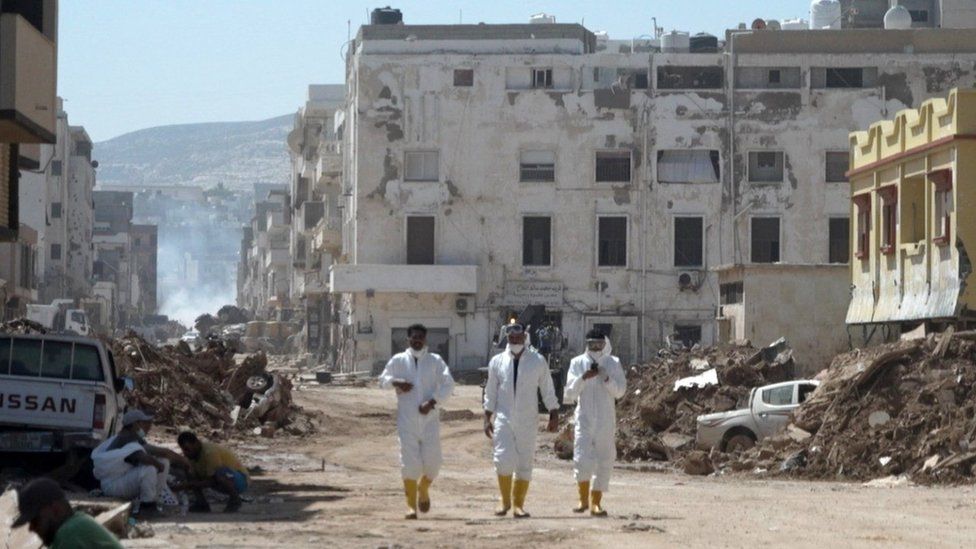This video can not be played
To play this video you need to enable JavaScript in your browser.
The journey to eastern Libyan city of Derna takes twice as long now.
Driving along the road from Benghazi, fields turn into rust-red lakes. As you get closer, the traffic begins to slow. Telegraph poles pulled from the ground by the floodwaters now lie haphazardly. Cars creep around holes in the highway, on hastily-dug detours carved out by diggers.
One of the closest bridges to Derna has been washed away completely. Locals stand near the ragged tarmac precipice, peering over and taking photos.
Not far beyond, soldiers hand out face masks to every car – for the driver, and each passenger. Everyone driving in the other direction is wearing them, and you soon realise why.
The smell of death in parts of the city feels almost impossible to describe. It fills your nostrils, part the scent of sewage, part something that’s harder to identify.
At times it is so strong it turns the stomach – especially as you stand overlooking the port where recovery teams tell me bodies are still washing up.
That morning they have found three. Carried in on the tide, they get trapped in the mounds of debris slowly rotting in the seawater.
Broken wood, whole cars lifted and dropped on top of scattered sea defences, tyres, fridges – everything mingles and swirls together in the stagnant water.
The pictures and videos which have come out of Derna have been graphic and shocking.
- Libyan official rejects blame for flood disaster
- BBC finds little foreign aid in flood-hit city
- CCTV shows cars swept away in Derna
But watching them does prepare you for the scale of the damage the floods have done to this place. The line of the river now gapes like an open wound, perhaps a hundred metres across in places. On these mounds of mud, nothing at all remains. It’s a barren wasteland.
The destructive power of the water has been extraordinary.
Cars lie around like toys tipped casually on their sides or resting upside-down. One has been pushed fully inside the terrace surrounding the distinctive Al Sahaba Mosque. Another is completely off the ground, embedded in the side of a building.

Walls made of thick concrete blocks have toppled. Sturdy trees have been plucked from the ground, their roots curling into the air. Everything else though, is gone.
This wasn’t just thousands of people washed away, it was their homes, their possessions, their lives. Humanity has been cleansed from this part of Derna.
For the survivors, life here has changed forever. There’s huge grief, and palpable anger.

Fairis Ghassar lost five members of his family in the raging waters.
“We were told to stay inside our homes,” he cries. “Why? They should have told us there was a storm, told us the dam was old and crumbling.
“Some of these destroyed buildings were a hundred years old. It’s all politics. There’s a government in the west, a government in the east. It’s a big problem.”
One of the dead was Faris’s ten-month-old daughter. He reaches for his phone to show me their pictures. First alive, and then their bodies, carefully wrapped in blankets, their faces showing their ordeal.
At the same time as we talk, a convoy of ministers is touring the disaster zone. They’re from the eastern government, one of Libya’s two opposing authorities. Their fighting has decimated the country’s infrastructure.
Faris claims this has proved fatal for his family.

I asked eastern Prime Minister Osama Hamad how this could happen when the dams were supposed to keep people safe?
“It was a very strong cyclone,” he told me. “Too strong for the dams. This is nature, and this is Allah.”
On the streets, there are rumours of a full evacuation of Derna.
Those left behind in the city are battling against the elements, with clean water and medical care in short supply. Almost a week after the deadly storm, the challenges facing its survivors are only growing.
Your device may not support this visualisation
